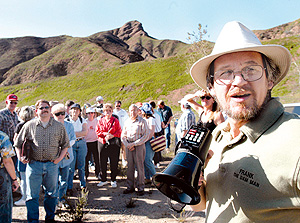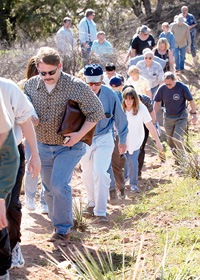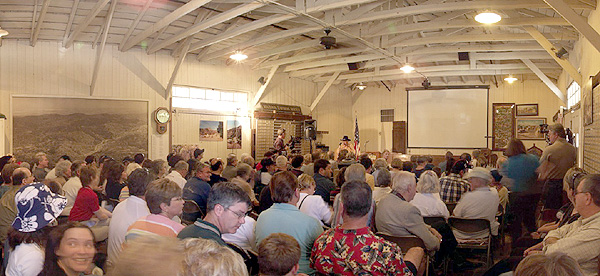|
|
Participants in the SCV Historical Society's 2003 tour of the St. Francis Dam site reach the top of the wing dyke. Photo by W. David Schwaderer.
A Walk Through History
Historian Frank "The Dam Man" Rock leads the way. Photo by Alex Collins/The Signal.
• SCV Historical Society conducts 75th anniversary tour of the St. Francis Dam site.By Patti Rasmussen
Signal Staff WriterMonday, March 10, 2003
t was standing room only as more than 150 people came to the Saugus Train Station on Sunday to hear about the second worst disaster in California history — the collapse of the St. Francis Dam in 1928 which claimed the lives of more than 450 people.
I
During his hour-long lecture, dam historian Frank Rock gave a brief history of the dam which was built for the city of Los Angeles in 1926 under the direction of William Mulholland.
Mulholland, manager and chief engineer of the Department of Water and Power and the man behind the California Aqueduct system, built the dam as part of a system of reservoirs designed to meet the needs of the growing city of Los Angeles which had an unstable water supply.
The San Francisquito site seemed ideal and the building began in August of 1924 and took two years to complete.
On March 12, 1928, just before midnight, the dam collapsed, sending a wall of water through San Francisquito Canyon that was 150 feet high when it reached Power Station Two.
Participants hike up the hill to the top of the wing dyke. Photo by Alex Collins/The Signal.
A landslide and the stress of all the water is believed to have caused the collapse. When it broke, billions of gallons of water escaped through the eastern portion of the St. Francis, taking about five hours to drain completely and taking with it homes, trees and hundreds of individuals.
The death toll officially stands at 495, but many believe that is a conservative estimate and put the number at somewhere around 600.
Rock highlighted his lecture with slides of the site and Dan DeVere sang an original song he composed about the dam.
Participants then loaded up on city buses which transported them to the original site with stops at Power Station 2 and a drive by the Ruiz Cemetery where many of the dam victims are buried.
After a steep hike up to the site overlooking the dam, Rock pointed out the various stress areas, where the dam originally crumbled and the remaining concrete walls left in the center.
Sharon Gayle and Dick Smith of Newhall said they enjoyed the tour.
"I was curious where the dam was located and I've lived here 13 years," Gayle said. "Besides, it's a lovely day to do this."
Emma White, 8, a third-grader at Emblem Elementary School attended the tour with her sister Chelsea, 4. Emma was visiting historic sites in the Santa Clarita for a social studies project.
"I think (the tour) was cool because we got to climb the hill," she said even though she decided to do her project on the Oak of the Golden Dream.
Rock, who grew up in the Santa Clarita Valley, said he took an interest in the dam site after moving back into town and getting involved in the Santa Clarita Valley Historical Society. He has been featured on the History Channel, Discovery and the Learning Channel as an expert in St. Francis Dam history, as well as SCVTV public access shows "Points of Interest" and "Legacy: Santa Clarita's Living History."
Western singer-songwriter Dan DeVere performs a song he co-wrote about the dam disaster, prior to the lecture inside the Saugus Train Station at Heritage Junction. Photo by W. David Schwaderer.
©2003, THE SIGNAL · USED BY PERMISSION · ALL RIGHTS RESERVED.
The site owner makes no assertions as to ownership of any original copyrights to digitized images. However, these images are intended for Personal or Research use only. Any other kind of use, including but not limited to commercial or scholarly publication in any medium or format, public exhibition, or use online or in a web site, may be subject to additional restrictions including but not limited to the copyrights held by parties other than the site owner. USERS ARE SOLELY RESPONSIBLE for determining the existence of such rights and for obtaining any permissions and/or paying associated fees necessary for the proposed use.



